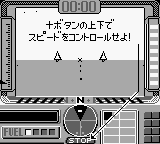X (1992 video game)
| X | |
|---|---|
 Official video game cover of X | |
| Developer(s) | Nintendo EAD |
| Publisher(s) | Nintendo |
| Director(s) | Yoshio Sakamoto |
| Producer(s) | Gunpei Yokoi |
| Designer(s) | Dylan Cuthbert[1] |
| Artist(s) | Kenichi Sugino[1] |
| Composer(s) | Kazumi Totaka[1], Hirokazu Tanaka (sound effects) |
| Platform(s) | Game Boy |
| Release |
|
| Genre(s) |
Combat simulation Vehicular combat |
| Mode(s) | Single-player |
X (エックス Ekkusu) is a three-dimensional first-person shooter video game released for the Game Boy only in Japan on May 29, 1992. The game was developed and published by Nintendo, with assistance from Argonaut Software. X was followed by an internationally released DSiWare exclusive sequel, X-Scape, in 2010.
History
The game was influenced by the Starglider series, and was originally slated to be published by Mindscape as Eclipse or Lunar Chase, but Nintendo took over the project after becoming interested in the concept of having three-dimensional graphics on the Game Boy. Then Nintendo president Hiroshi Yamauchi renamed the game X, shortly before its release. The Japanese gaming magazine Famitsu listed X as one of the four most influential Game Boy games released, as it was the first 3D game released for a portable system in Japan.
Plot
In the space age year XXXX, overpopulation on the Earth is forcing humans to search for a new home in outer space. Planet Tetamus II is discovered to have an environment similar to earth, and mining of the planet's high-energy "Power Crystal" mineral leads to the construction of the "Nuclear Silo" designed to convert this mineral into energy. The future seemed bright for the human race, until an emergency message from Tetamus II reported that a cargo ship loaded with power crystals had been shot down by an army of alien starships. The aliens intend to use the planet as a base for conquering the rest of the universe, and the space tank "VIXIV" is sent out to destroy the alien forces.
Gameplay

The game takes place in a wireframe 3D view. The player controls the VIXIV to complete various missions assigned by the Training Academy Coach. Objectives can range from destroying enemy targets, escorting cargo, or defending bases. A short break is provided after the completion of each mission, and the player is awarded a number of stars based on their skill in each level. 10 small stars equal one regular star, and a certain number of stars are needed to continue the game after failing a mission. The game is completed by finishing all ten missions.
See also
- Battlezone, a 1980 arcade game by Atari Games with similar gameplay and vector graphics.